-
 Bitcoin
Bitcoin $108,043.3894
-1.71% -
 Ethereum
Ethereum $2,519.1878
-3.09% -
 Tether USDt
Tether USDt $1.0004
-0.01% -
 XRP
XRP $2.2231
-2.72% -
 BNB
BNB $655.3607
-1.06% -
 Solana
Solana $148.3620
-2.84% -
 USDC
USDC $1.0000
0.00% -
 TRON
TRON $0.2838
-0.37% -
 Dogecoin
Dogecoin $0.1648
-4.79% -
 Cardano
Cardano $0.5759
-3.97% -
 Hyperliquid
Hyperliquid $38.4598
-5.19% -
 Sui
Sui $2.9005
-4.22% -
 Bitcoin Cash
Bitcoin Cash $481.1531
-3.80% -
 Chainlink
Chainlink $13.1936
-4.50% -
 UNUS SED LEO
UNUS SED LEO $9.0471
0.41% -
 Avalanche
Avalanche $17.9444
-4.20% -
 Stellar
Stellar $0.2378
-2.60% -
 Toncoin
Toncoin $2.7850
-3.38% -
 Shiba Inu
Shiba Inu $0.0...01148
-3.75% -
 Litecoin
Litecoin $87.3159
-3.73% -
 Hedera
Hedera $0.1557
-3.02% -
 Monero
Monero $314.0980
-1.98% -
 Polkadot
Polkadot $3.3909
-5.10% -
 Dai
Dai $1.0001
0.00% -
 Ethena USDe
Ethena USDe $1.0002
-0.02% -
 Bitget Token
Bitget Token $4.4147
-3.74% -
 Uniswap
Uniswap $6.9933
-9.59% -
 Pepe
Pepe $0.0...09661
-6.72% -
 Aave
Aave $264.1417
-6.16% -
 Pi
Pi $0.4705
-5.23%
How to choose a PEPE exchange? How to evaluate security?
Choosing the right PEPE exchange involves evaluating liquidity, fees, user interface, and security features like 2FA, cold storage, and encryption for a safe trading experience.
May 01, 2025 at 07:14 pm
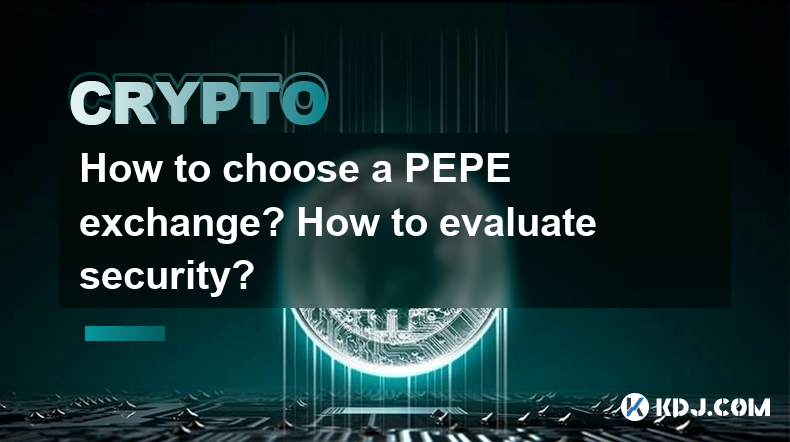
Choosing a PEPE exchange and evaluating its security are crucial steps for any cryptocurrency investor. PEPE, a meme coin inspired by the popular Pepe the Frog internet meme, has gained significant attention in the crypto community. To ensure a safe and efficient trading experience, it is essential to carefully select an exchange and assess its security features. This article will guide you through the process of choosing a suitable PEPE exchange and evaluating its security.
Understanding the Importance of Choosing the Right Exchange
Selecting the right exchange for trading PEPE is vital for several reasons. An exchange acts as the gateway to the cryptocurrency market, allowing you to buy, sell, and trade digital assets. The right exchange should offer a seamless user experience, competitive fees, and robust security measures. A poor choice can lead to financial losses, compromised personal information, and a frustrating trading experience. Therefore, it is crucial to evaluate various factors before deciding on an exchange.
Factors to Consider When Choosing a PEPE Exchange
When choosing a PEPE exchange, several key factors should be taken into account. These include:
- Liquidity: High liquidity ensures that you can buy and sell PEPE quickly and at a fair price. Look for exchanges with significant trading volumes for PEPE.
- Fees: Transaction fees can significantly impact your trading profits. Compare the fee structures of different exchanges to find the most cost-effective option.
- User Interface: A user-friendly interface can enhance your trading experience. Ensure the exchange's platform is intuitive and easy to navigate.
- Customer Support: Reliable customer support is essential for resolving any issues that may arise during trading. Check the exchange's reputation for customer service.
- Regulation and Compliance: Opt for exchanges that adhere to regulatory standards and have a strong compliance framework. This can provide an added layer of security and legitimacy.
Evaluating the Security of a PEPE Exchange
Security is a paramount concern when selecting a PEPE exchange. To evaluate an exchange's security, consider the following aspects:
- Two-Factor Authentication (2FA): 2FA adds an extra layer of security by requiring a secondary form of verification, such as a text message or an authenticator app, to access your account.
- Cold Storage: Exchanges that store a significant portion of user funds in cold storage (offline wallets) are less vulnerable to hacking attempts. Verify if the exchange uses cold storage and the percentage of funds kept offline.
- Encryption: Robust encryption protocols protect your data and transactions from unauthorized access. Ensure the exchange uses industry-standard encryption methods.
- Security Audits: Regular security audits by reputable firms can help identify and address vulnerabilities. Check if the exchange undergoes periodic audits and if the results are publicly available.
- Insurance: Some exchanges offer insurance to cover potential losses due to security breaches. Verify if the exchange provides insurance and the extent of coverage.
Step-by-Step Guide to Evaluating an Exchange's Security
To thoroughly evaluate the security of a PEPE exchange, follow these steps:
- Research the Exchange's Security Features: Visit the exchange's website and review its security page. Look for information on 2FA, cold storage, encryption, and insurance.
- Check for Security Audits: Search for reports of security audits conducted on the exchange. Reputable firms like Trail of Bits or Quantstamp are known for their thorough audits.
- Read User Reviews and Testimonials: Visit forums and review sites to gather insights from other users about their experiences with the exchange's security.
- Enable 2FA: Once you decide to use the exchange, immediately enable 2FA on your account. Download an authenticator app and follow the exchange's instructions to set it up.
- Monitor Your Account: Regularly check your account for any suspicious activity. Set up alerts for withdrawals and logins to stay informed of any unauthorized access attempts.
Comparing Different PEPE Exchanges
To make an informed decision, it is helpful to compare different PEPE exchanges. Here is a comparison of three popular exchanges that support PEPE trading:
- Binance: Known for its high liquidity and low fees, Binance offers a wide range of trading pairs, including PEPE. It has robust security measures, including 2FA and cold storage, and undergoes regular security audits.
- KuCoin: KuCoin is another popular choice for PEPE trading, offering competitive fees and a user-friendly interface. It supports 2FA and cold storage, and it has a strong reputation for customer support.
- Uniswap: As a decentralized exchange, Uniswap allows for PEPE trading without the need for a centralized intermediary. It uses smart contracts for security, but users must be aware of the risks associated with decentralized platforms.
Making the Final Decision
After evaluating the factors mentioned above and comparing different exchanges, you can make an informed decision on which PEPE exchange to use. Consider your trading needs, risk tolerance, and the importance of security features. Remember that no exchange is perfect, and it is essential to stay vigilant and keep your account secure.
Frequently Asked Questions
Q: Can I trade PEPE on multiple exchanges simultaneously?
A: Yes, you can trade PEPE on multiple exchanges simultaneously. This can help you take advantage of different liquidity pools and trading pairs. However, managing multiple accounts requires careful monitoring to ensure security and efficiency.
Q: Are there any specific risks associated with trading PEPE on decentralized exchanges?
A: Yes, trading PEPE on decentralized exchanges (DEXs) carries specific risks. These include smart contract vulnerabilities, impermanent loss for liquidity providers, and the potential for front-running. Always conduct thorough research and understand the risks before trading on a DEX.
Q: How often should I review the security features of my chosen PEPE exchange?
A: It is recommended to review the security features of your chosen PEPE exchange at least quarterly. This includes checking for updates on security protocols, new audit reports, and any changes in the exchange's security policies.
Q: What should I do if I suspect my PEPE exchange account has been compromised?
A: If you suspect your PEPE exchange account has been compromised, immediately change your password and enable 2FA if it is not already enabled. Contact the exchange's customer support to report the issue and follow their instructions for securing your account and recovering any lost funds.
Disclaimer:info@kdj.com
The information provided is not trading advice. kdj.com does not assume any responsibility for any investments made based on the information provided in this article. Cryptocurrencies are highly volatile and it is highly recommended that you invest with caution after thorough research!
If you believe that the content used on this website infringes your copyright, please contact us immediately (info@kdj.com) and we will delete it promptly.
- Bitcoin's Pattern Break: Are HODLers the Key to the Next Surge?
- 2025-07-04 18:50:12
- Bitcoin Price, Trump's Bill, and the $150K Dream: A NYC Take
- 2025-07-04 19:50:12
- Ethereum, LILPEPE, and the July Bounce: Will Pepe Steal ETH's Thunder?
- 2025-07-04 19:10:12
- Binance Institutional Loans: Unlocking 4x Leverage and Zero Interest for Whales
- 2025-07-04 19:15:12
- Bitcoin Bull Run: Analysts Eye Peak in Late 2025?
- 2025-07-04 19:20:13
- Pepe Indicators, Bullish Forecast: Can the Meme Coin Rally?
- 2025-07-04 19:25:12
Related knowledge
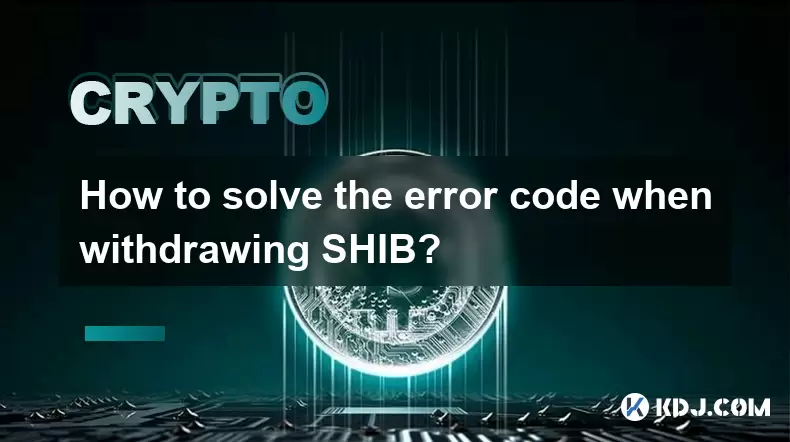
How to solve the error code when withdrawing SHIB?
May 14,2025 at 02:22am
Understanding Error Codes When Withdrawing SHIBWhen you attempt to withdraw Shiba Inu (SHIB) from an exchange or wallet, you might encounter various error codes. Understanding these error codes is crucial to successfully completing your transactions. Error codes are typically generated to inform users of specific issues that need to be addressed before ...

Can the SHIB withdrawal address be reused? Is it safe?
May 13,2025 at 04:42pm
Introduction to SHIB Withdrawal AddressesWhen it comes to Shiba Inu (SHIB) transactions, one of the critical aspects users need to understand is the nature and safety of withdrawal addresses. The SHIB withdrawal address plays a pivotal role in ensuring that your tokens are transferred securely from one wallet to another. A common question among users is...

What is the minimum withdrawal amount for SHIB? Is there a threshold?
May 13,2025 at 03:29pm
When it comes to withdrawing SHIB (Shiba Inu) from various cryptocurrency platforms, understanding the minimum withdrawal amount and any associated thresholds is crucial for managing your transactions efficiently. This article will delve into the specifics of SHIB withdrawals, focusing on the minimum amounts required, how these thresholds are set, and w...
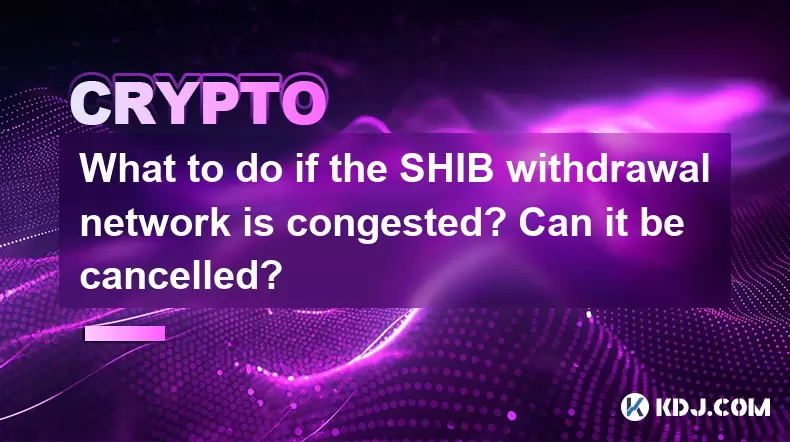
What to do if the SHIB withdrawal network is congested? Can it be cancelled?
May 13,2025 at 05:07pm
If you're facing issues with the SHIB withdrawal network being congested, it's important to understand your options and the steps you can take. Congestion in the network can lead to delays in transaction processing, and knowing whether you can cancel a pending transaction is crucial. Let's explore this topic in detail. Understanding SHIB Withdrawal Netw...
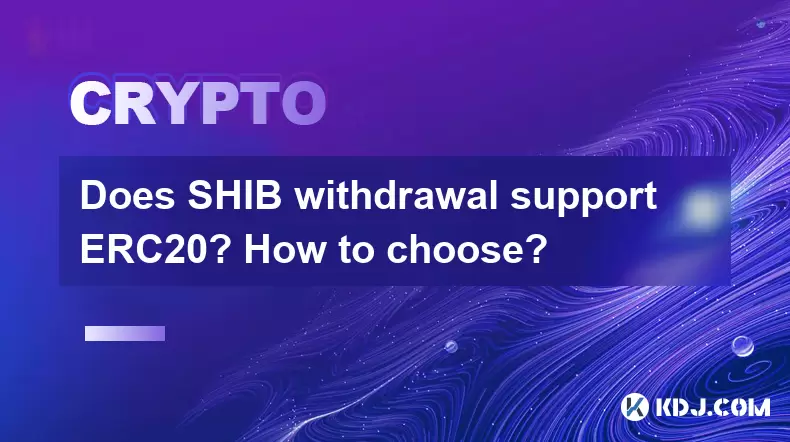
Does SHIB withdrawal support ERC20? How to choose?
May 14,2025 at 02:56am
Does SHIB withdrawal support ERC20? How to choose? Shiba Inu (SHIB) is a popular cryptocurrency that often raises questions about its withdrawal options, particularly in relation to the ERC20 token standard. This article will explore whether SHIB withdrawal supports ERC20 and provide a detailed guide on how to choose the best withdrawal method for your ...
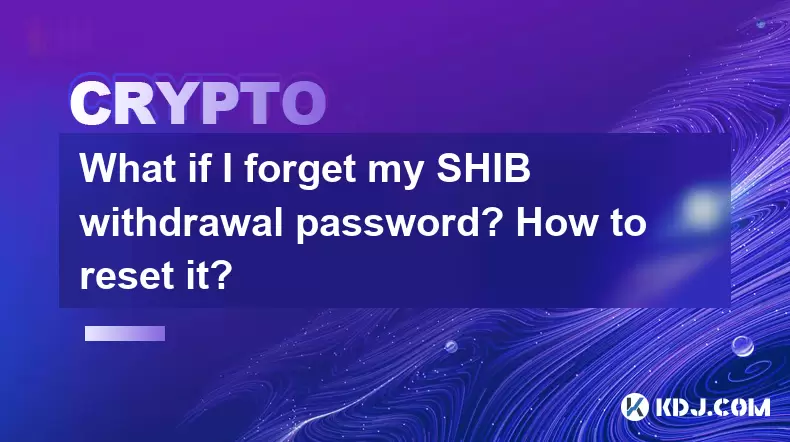
What if I forget my SHIB withdrawal password? How to reset it?
May 13,2025 at 03:15pm
Forgetting your SHIB withdrawal password can be a stressful experience, especially if you are eager to access your funds. Fortunately, there are steps you can take to reset your password and regain access to your SHIB. This article will guide you through the process of resetting your SHIB withdrawal password, ensuring that you can continue to manage you...

How to solve the error code when withdrawing SHIB?
May 14,2025 at 02:22am
Understanding Error Codes When Withdrawing SHIBWhen you attempt to withdraw Shiba Inu (SHIB) from an exchange or wallet, you might encounter various error codes. Understanding these error codes is crucial to successfully completing your transactions. Error codes are typically generated to inform users of specific issues that need to be addressed before ...

Can the SHIB withdrawal address be reused? Is it safe?
May 13,2025 at 04:42pm
Introduction to SHIB Withdrawal AddressesWhen it comes to Shiba Inu (SHIB) transactions, one of the critical aspects users need to understand is the nature and safety of withdrawal addresses. The SHIB withdrawal address plays a pivotal role in ensuring that your tokens are transferred securely from one wallet to another. A common question among users is...

What is the minimum withdrawal amount for SHIB? Is there a threshold?
May 13,2025 at 03:29pm
When it comes to withdrawing SHIB (Shiba Inu) from various cryptocurrency platforms, understanding the minimum withdrawal amount and any associated thresholds is crucial for managing your transactions efficiently. This article will delve into the specifics of SHIB withdrawals, focusing on the minimum amounts required, how these thresholds are set, and w...

What to do if the SHIB withdrawal network is congested? Can it be cancelled?
May 13,2025 at 05:07pm
If you're facing issues with the SHIB withdrawal network being congested, it's important to understand your options and the steps you can take. Congestion in the network can lead to delays in transaction processing, and knowing whether you can cancel a pending transaction is crucial. Let's explore this topic in detail. Understanding SHIB Withdrawal Netw...

Does SHIB withdrawal support ERC20? How to choose?
May 14,2025 at 02:56am
Does SHIB withdrawal support ERC20? How to choose? Shiba Inu (SHIB) is a popular cryptocurrency that often raises questions about its withdrawal options, particularly in relation to the ERC20 token standard. This article will explore whether SHIB withdrawal supports ERC20 and provide a detailed guide on how to choose the best withdrawal method for your ...

What if I forget my SHIB withdrawal password? How to reset it?
May 13,2025 at 03:15pm
Forgetting your SHIB withdrawal password can be a stressful experience, especially if you are eager to access your funds. Fortunately, there are steps you can take to reset your password and regain access to your SHIB. This article will guide you through the process of resetting your SHIB withdrawal password, ensuring that you can continue to manage you...
See all articles

























































































